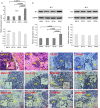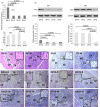Expression of melatonin receptors and CD4 in the ovine thymus, lymph node, spleen and liver during early pregnancy
- PMID: 32052861
- PMCID: PMC7160654
- DOI: 10.1111/imm.13180
Expression of melatonin receptors and CD4 in the ovine thymus, lymph node, spleen and liver during early pregnancy
Abstract
As a pineal gland hormone, melatonin acts through its receptors to modulate the immune system. The immune system is composed of primary and secondary organs, and immune organs are adapted to the presence of the fetal alloantigen during pregnancy. However, it is unclear whether melatonin affects maternal immune organs during early pregnancy in sheep. In this study, the ovine thymus, lymph node, spleen and liver were sampled at day 16 of the oestrous cycle, and at days 13, 16 and 25 of pregnancy. The expression of melatonin receptor 1A (MT1), melatonin receptor 1B (MT2) and cluster of differentiation 4 (CD4) was detected by quantitative real-time polymerase chain reaction, Western blot and immunohistochemistry experiments. Our results showed that during early pregnancy there was an upregulation of MT1 mRNA and protein in the thymus, lymph node and liver, and there was a downregulation in the spleen. The expression of MT2 mRNA and protein was increased in the thymus but decreased in the spleen and liver, and there was no significant change in the lymph node during early pregnancy. CD4 protein was upregulated in the thymus, lymph node and liver, but there were no significant changes in the spleen during early pregnancy. In conclusion, early pregnancy induces tissue-specific expression of MT1, MT2 and CD4, which may be due to the different functions of the thymus, lymph node, spleen and liver. Further, melatonin is involved in immune regulation of the maternal thymus, lymph node, spleen and liver during early pregnancy in sheep.
Keywords: liver; lymph node; melatonin receptor; spleen; thymus.
© 2020 John Wiley & Sons Ltd.
Figures





References
-
- Hansen PJ. The immunology of early pregnancy in farm animals. Reprod Domest Anim 2011; 46:18–30. - PubMed
-
- Oliveira LJ, Barreto RS, Perecin F, Mansouri‐Attia N, Pereira FT, Meirelles FV. Modulation of maternal immune system during pregnancy in the cow. Reprod Domest Anim 2012; 47:384–93. - PubMed
-
- Yang L, Zhang LY, Qiao HY, Liu N, Wang YX, Li SJ. Maternal immune regulation by conceptus during early pregnancy in the bovine. Asian J Anim Vet Adv 2014; 9:610–20.
-
- Parker GA, Papenfuss TL. Chapter 10 ‐ Immune system In: Atlas of Histology of the Juvenile Rat. New York: Academic Press, 2016: 293–347.
Publication types
MeSH terms
Substances
Associated data
- Actions
- Actions
- Actions
LinkOut - more resources
Full Text Sources
Research Materials

